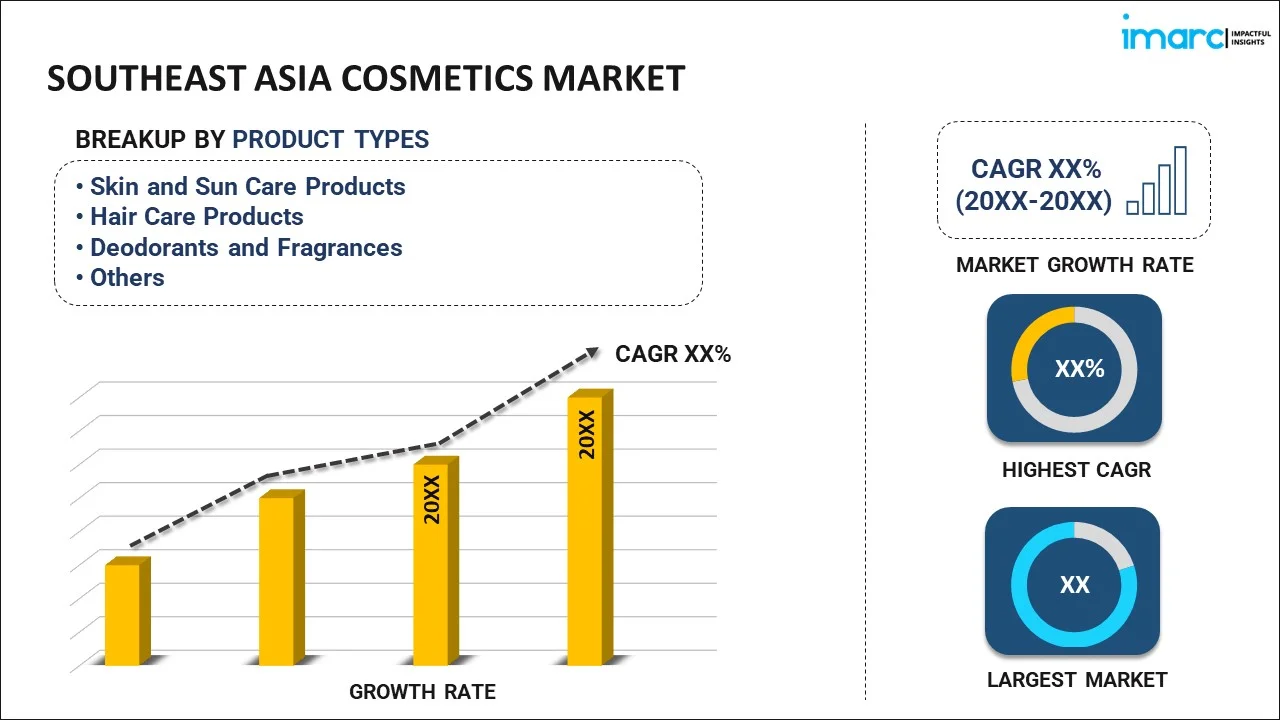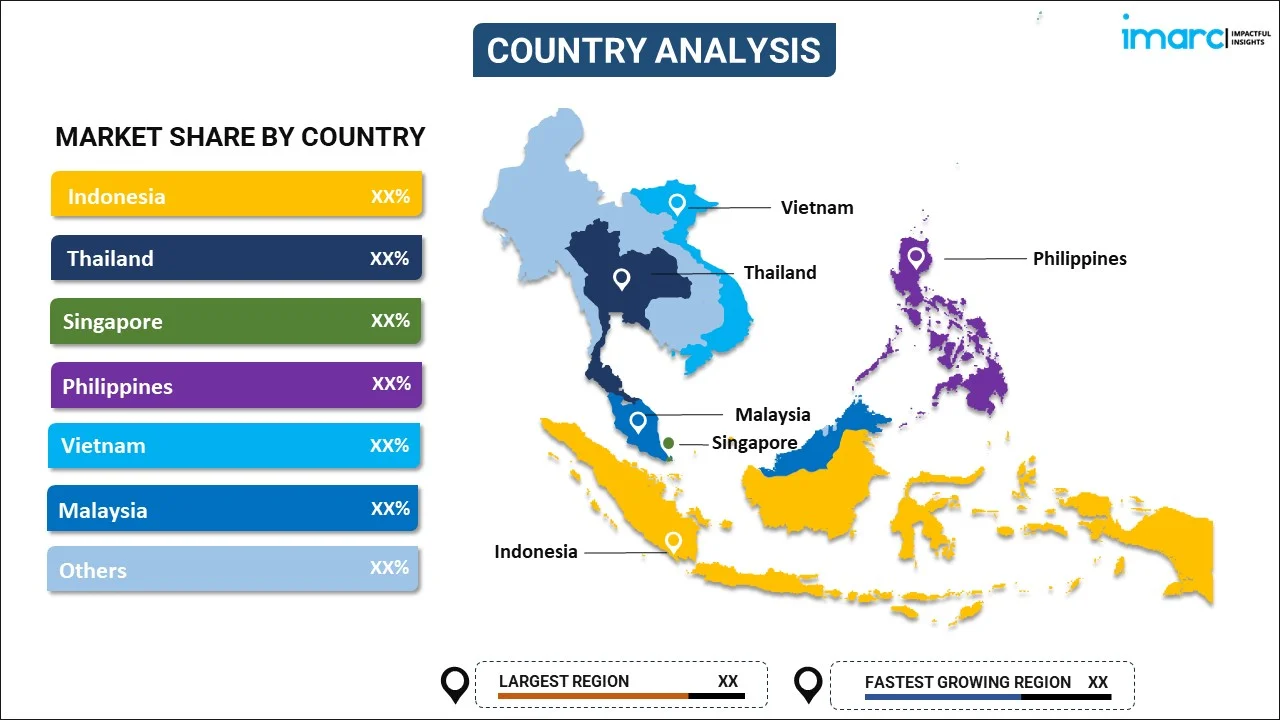
Southeast Asia Cosmetics Market Report by Product Type (Skin and Sun Care Products, Hair Care Products, Deodorants and Fragrances, Makeup and Color Cosmetics, and Others), Category (Conventional, Organic), Gender (Men, Women, Unisex), Distribution Channel (Supermarkets and Hypermarkets, Specialty Stores, Pharmacies, Online Stores, and Others), and Country 2025-2033
Market Overview:
Southeast Asia cosmetics market size is projected to exhibit a growth rate (CAGR) of 4.04% during 2025-2033. The growing consumer preferences, the rising focus on skincare, and a surge in beauty consciousness are primarily augmenting the regional market.
|
Report Attribute
|
Key Statistics
|
|---|---|
|
Base Year
|
2024 |
|
Forecast Years
|
2025-2033
|
|
Historical Years
|
2019-2024
|
| Market Growth Rate (2025-2033) | 4.04% |
Cosmetics encompass an extensive array of products utilized for personal care, grooming, and the enhancement of one's appearance. These items are crafted for application on the body, face, hair, nails, or lips, with the aim of refining or modifying an individual's aesthetic features. Available in diverse forms such as creams, lotions, powders, gels, serums, and sprays, cosmetics are commonly employed by both men and women, serving a multitude of purposes. Within the realm of cosmetics, there exists a broad spectrum of skincare products, including cleansers, moisturizers, serums, toners, masks, and anti-aging treatments. These formulations are designed to fulfill functions such as cleansing, hydrating, nourishing, protecting, and enhancing the overall health and visual appeal of the skin.
Southeast Asia Cosmetics Market Trends:
The Southeast Asia cosmetics market stands as a vibrant and rapidly growing sector, reflecting the region's evolving beauty and personal care landscape. Additionally, the market caters to a broad demographic, with both men and women actively engaging in personal care and grooming routines. Besides this, the escalating demand for cosmetics is influenced by factors such as cultural aesthetics, urbanization, and an increasing middle-class population with rising disposable incomes. Furthermore, the region's consumers exhibit a growing interest in skincare routines, driving the demand for products that cleanse, hydrate, nourish, and protect the skin. The market is characterized by a dynamic landscape, with both local and international beauty brands competing to meet the diverse needs of consumers. Apart from this, the influence of social media and online platforms has significantly contributed to the awareness and popularity of beauty trends, influencing purchasing decisions across the region. As the Southeast Asia cosmetics market continues to expand, there is a notable trend toward eco-friendly and sustainable products. Beauty-conscious consumers are increasingly seeking ethical and environmentally friendly options, prompting the industry to respond with innovative formulations and packaging. With a youthful and discerning consumer base, the Southeast Asia cosmetics market is poised for sustained growth over the forecasted period.
Southeast Asia Cosmetics Market Segmentation:
IMARC Group provides an analysis of the key trends in each segment of the market, along with forecasts at the regional and country levels for 2025-2033. Our report has categorized the market based on product type, category, gender, and distribution channel.
Product Type Insights:

- Skin and Sun Care Products
- Hair Care Products
- Deodorants and Fragrances
- Makeup and Color Cosmetics
- Others
The report has provided a detailed breakup and analysis of the market based on the product type. This includes skin and sun care products, hair care products, deodorants and fragrances, makeup and color cosmetics, and others.
Category Insights:
- Conventional
- Organic
A detailed breakup and analysis of the market based on the category have also been provided in the report. This includes conventional and organic.
Gender Insights:
- Men
- Women
- Unisex
The report has provided a detailed breakup and analysis of the market based on the gender. This includes men, women, and unisex.
Distribution Channel Insights:
- Supermarkets and Hypermarkets
- Specialty Stores
- Pharmacies
- Online Stores
- Others
A detailed breakup and analysis of the market based on the distribution channel have also been provided in the report. This includes supermarkets and hypermarkets, specialty stores, pharmacies, online stores, and others.
Country Insights:

- Indonesia
- Thailand
- Singapore
- Philippines
- Vietnam
- Malaysia
- Others
The report has also provided a comprehensive analysis of all the major regional markets, which include Indonesia, Thailand, Singapore, Philippines, Vietnam, Malaysia, and Others.
Competitive Landscape:
The market research report has also provided a comprehensive analysis of the competitive landscape in the market. Competitive analysis such as market structure, key player positioning, top winning strategies, competitive dashboard, and company evaluation quadrant has been covered in the report. Also, detailed profiles of all major companies have been provided. Some of the key players include:
- Chanel Limited
- Clara International Beauty Group
- Ivy Beauty Corporation Sdn Bhd
- Martha Tilaar Group
- Procter & Gamble
- SO.LEK Cosmetics
- Wardah
- Wipro Unza Holdings Ltd.
(Please note that this is only a partial list of the key players, and the complete list is provided in the report.)
Southeast Asia Cosmetics Market Report Coverage:
| Report Features | Details |
|---|---|
| Base Year of the Analysis | 2024 |
| Historical Period | 2019-2024 |
| Forecast Period | 2025-2033 |
| Units | Million USD |
| Scope of the Report | Exploration of Historical and Forecast Trends, Industry Catalysts and Challenges, Segment-Wise Historical and Predictive Market Assessment:
|
| Product Types Covered | Skin and Sun Care Products, Hair Care Products, Deodorants and Fragrances, Makeup and Color Cosmetics, Others |
| Categories Covered | Conventional, Organic |
| Genders Covered | Men, Women, Unisex |
| Distribution Channels Covered | Supermarkets and Hypermarkets, Specialty Stores, Pharmacies, Online Stores, Others |
| Countries Covered | Indonesia, Thailand, Singapore, Philippines, Vietnam, Malaysia, Others |
| Companies Covered | Chanel Limited, Clara International Beauty Group, Ivy Beauty Corporation Sdn Bhd, Martha Tilaar Group, Procter & Gamble, SO.LEK Cosmetics, Wardah, Wipro Unza Holdings Ltd., etc. |
| Customization Scope | 10% Free Customization |
| Post-Sale Analyst Support | 10-12 Weeks |
| Delivery Format | PDF and Excel through Email (We can also provide the editable version of the report in PPT/Word format on special request) |
Key Questions Answered in This Report:
- How has the Southeast Asia cosmetics market performed so far and how will it perform in the coming years?
- What has been the impact of COVID-19 on the Southeast Asia cosmetics market?
- What is the breakup of the Southeast Asia cosmetics market on the basis of product type?
- What is the breakup of the Southeast Asia cosmetics market on the basis of category?
- What is the breakup of the Southeast Asia cosmetics market on the basis of gender?
- What is the breakup of the Southeast Asia cosmetics market on the basis of distribution channel?
- What are the various stages in the value chain of the Southeast Asia cosmetics market?
- What are the key driving factors and challenges in the Southeast Asia cosmetics?
- What is the structure of the Southeast Asia cosmetics market and who are the key players?
- What is the degree of competition in the Southeast Asia cosmetics market?
Key Benefits for Stakeholders:
- IMARC’s industry report offers a comprehensive quantitative analysis of various market segments, historical and current market trends, market forecasts, and dynamics of the Southeast Asia cosmetics market from 2019-2033.
- The research report provides the latest information on the market drivers, challenges, and opportunities in the Southeast Asia cosmetics market.
- Porter's five forces analysis assist stakeholders in assessing the impact of new entrants, competitive rivalry, supplier power, buyer power, and the threat of substitution. It helps stakeholders to analyze the level of competition within the Southeast Asia cosmetics industry and its attractiveness.
- Competitive landscape allows stakeholders to understand their competitive environment and provides an insight into the current positions of key players in the market.
Need more help?
- Speak to our experienced analysts for insights on the current market scenarios.
- Include additional segments and countries to customize the report as per your requirement.
- Gain an unparalleled competitive advantage in your domain by understanding how to utilize the report and positively impacting your operations and revenue.
- For further assistance, please connect with our analysts.
 Inquire Before Buying
Inquire Before Buying
 Speak to an Analyst
Speak to an Analyst
 Request Brochure
Request Brochure
 Request Customization
Request Customization




.webp)




.webp)












